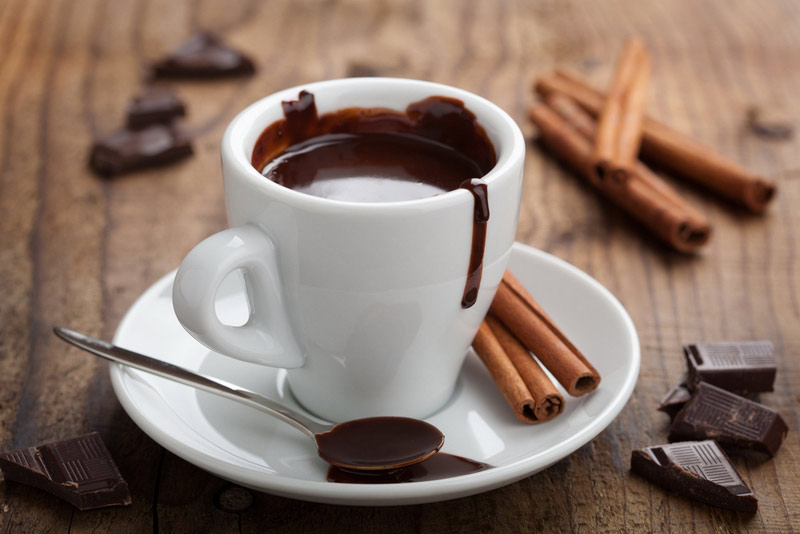The 6 Worst Ingredients Found in Store-Bought Hot Chocolate (& How to Make Your Own)

There’s nothing more satisfying than sitting down to a steaming cup of cocoa, cozied up with a blanket and your favorite Netflix show.
Unfortunately, that classic drink you’re sipping on could be loaded with unhealthy additives and artificial sweeteners. So before you reach for another hot cocoa packet, make sure you know which unhealthy toxins might be lurking in your drink.
Oh, and we also included an easy, Paleo hot chocolate recipe that’s sooo much better for you – and tastier, too!
The 6 Worst Ingredients in Your Hot Chocolate Mix

Carrageenan
This ingredient is popping up in organic food products everywhere, from deli meat to almond milk and beyond. It gives food a familiar texture and acts as an emulsifier in products like yogurt, milk, and hot cocoa powder. It’s considered “natural” because it is derived from Irish seaweed, but it is a highly processed ingredient that is far from a whole food. Carrageenan is considered to be an inflammatory additive that can cause digestive upset and is even associated with cancer. (1)
Alkali
Many hot chocolate powders read “cocoa processed with alkali”, but most people don’t know what that means. Raw cocoa powder is basically pure cocoa beans that are ground into powder. However, in their natural form, cocoa beans can be acidic and bitter, with more of a coffee taste than a chocolate taste. The signature hot chocolate taste is achieved by processing cocoa beans with a chemical agent to alkalize them and remove the bitterness. So cocoa processed with alkali is chemically changed. And while that doesn’t make it harmful, it reduces the nutritional benefits.
Corn Syrup
Processed to be significantly sweeter than cane sugar, corn syrup is an inflammatory ingredient that can lead to issues with insulin and blood sugar. (2) Corn syrup is also a highly processed food that is made by combining corn starch, water, and fungal enzymes. The enzymes reduce the corn starch to glucose molecules, resulting in a highly sweet syrup that is cheaper than cane sugar, but far less natural or nutritious.
Vegetable Oil
Vegetable oil is notoriously deceptive. This ingredient is usually a combination of canola or corn oil, neither of which are true vegetables. Both are highly processed with extreme temperatures, leaving them void of any potential nutrients. Vegetable oil also contains inflammatory omega-6 fatty acids in high ratios, and can also be a source of trans fats, which aren’t safe to be consumed at any level. These are often added to hot cocoa products to give it a smooth texture.
Sucralose
An artificial sweetener, sucralose has become a preferred sweetener because it hasn’t yet been vilified as much as Splenda – even though they’re the same ingredient. Sucralose is a favorite choice for hot chocolate products because it contains no calories but packs a super sweet punch. Perhaps the biggest hot cocoa-related issue with sucralose is that when it is cooked, it can break down and interact with other ingredients, resulting in a potentially toxic food. (3)
Maltodextrin
Maltodextrin is most commonly made from corn, but it can also be made from wheat or rice. It is a food additive that is processed with high temperatures, rendering it completely void of the original food qualities it might have possessed. This additive is another corn-based sweetener that is less sweet than corn syrup, but is still close to 20 percent sugar. The main purpose of maltodextrin in hot chocolate is to create a thicker product while also extending shelf life.
Bottom Line
While hot cocoa is a favorite beverage during the cooler months, conventional products on store shelves can be stocked with potentially toxic ingredients. Instead of relying on these store-bought products, you can get a tastier, safer alternative by making your own.
How to Make Your Own Hot Chocolate
This recipe will produce a very dark chocolate taste. So, if you prefer a milk chocolate flavor, adjust the amount of chocolate accordingly. You can also jazz up your hot cocoa by swapping some of the milk with brewed coffee for a mocha, or you can add more butter for a bulletproof version!
Healthy, Homemade Hot Chocolate

Recipe by: Aimee McNew
Total time: 5 mins
Cook Time: 5 mins
Yield: 1 serving
Ingredients:
- 6 oz almond or coconut milk
- 4-6 T cacao powder
- 1-2 squares of 80% dark chocolate
- 1 T coconut sugar
- 1 T vanilla extract
- ½ t coconut oil or grass-fed butter
- Pinch of Ceylon cinnamon (optional)
Directions:
- In a small saucepan, heat the milk over medium heat until it just starts to bubble – not rapid boil.
- As soon as the milk is bubbling, add the cacao powder, chocolate, sugar, vanilla, and coconut oil. Stir with a whisk for a minute, then remove from heat.
- Add ingredients to a blender and pulse a few times until whipped and frothy.
- Optional: Top with the pinch of cinnamon or other favorite toppings, like whipped coconut cream or Paleo marshmallows.
(Read This Next: 5 Natural Benefits of Drinking Coffee and Surprising Side Effects)
The post The 6 Worst Ingredients Found in Store-Bought Hot Chocolate (& How to Make Your Own) appeared first on PaleoPlan.
from PaleoPlan https://ift.tt/2ETvDJm
Entry Published : October 31, 2018 at 12:29PM
EntryContent :

There’s nothing more satisfying than sitting down to a steaming cup of cocoa, cozied up with a blanket and your favorite Netflix show.
Unfortunately, that classic drink you’re sipping on could be loaded with unhealthy additives and artificial sweeteners. So before you reach for another hot cocoa packet, make sure you know which unhealthy toxins might be lurking in your drink.
Oh, and we also included an easy, Paleo hot chocolate recipe that’s sooo much better for you – and tastier, too!
The 6 Worst Ingredients in Your Hot Chocolate Mix

Carrageenan
This ingredient is popping up in organic food products everywhere, from deli meat to almond milk and beyond. It gives food a familiar texture and acts as an emulsifier in products like yogurt, milk, and hot cocoa powder. It’s considered “natural” because it is derived from Irish seaweed, but it is a highly processed ingredient that is far from a whole food. Carrageenan is considered to be an inflammatory additive that can cause digestive upset and is even associated with cancer. (1)
Alkali
Many hot chocolate powders read “cocoa processed with alkali”, but most people don’t know what that means. Raw cocoa powder is basically pure cocoa beans that are ground into powder. However, in their natural form, cocoa beans can be acidic and bitter, with more of a coffee taste than a chocolate taste. The signature hot chocolate taste is achieved by processing cocoa beans with a chemical agent to alkalize them and remove the bitterness. So cocoa processed with alkali is chemically changed. And while that doesn’t make it harmful, it reduces the nutritional benefits.
Corn Syrup
Processed to be significantly sweeter than cane sugar, corn syrup is an inflammatory ingredient that can lead to issues with insulin and blood sugar. (2) Corn syrup is also a highly processed food that is made by combining corn starch, water, and fungal enzymes. The enzymes reduce the corn starch to glucose molecules, resulting in a highly sweet syrup that is cheaper than cane sugar, but far less natural or nutritious.
Vegetable Oil
Vegetable oil is notoriously deceptive. This ingredient is usually a combination of canola or corn oil, neither of which are true vegetables. Both are highly processed with extreme temperatures, leaving them void of any potential nutrients. Vegetable oil also contains inflammatory omega-6 fatty acids in high ratios, and can also be a source of trans fats, which aren’t safe to be consumed at any level. These are often added to hot cocoa products to give it a smooth texture.
Sucralose
An artificial sweetener, sucralose has become a preferred sweetener because it hasn’t yet been vilified as much as Splenda – even though they’re the same ingredient. Sucralose is a favorite choice for hot chocolate products because it contains no calories but packs a super sweet punch. Perhaps the biggest hot cocoa-related issue with sucralose is that when it is cooked, it can break down and interact with other ingredients, resulting in a potentially toxic food. (3)
Maltodextrin
Maltodextrin is most commonly made from corn, but it can also be made from wheat or rice. It is a food additive that is processed with high temperatures, rendering it completely void of the original food qualities it might have possessed. This additive is another corn-based sweetener that is less sweet than corn syrup, but is still close to 20 percent sugar. The main purpose of maltodextrin in hot chocolate is to create a thicker product while also extending shelf life.
Bottom Line
While hot cocoa is a favorite beverage during the cooler months, conventional products on store shelves can be stocked with potentially toxic ingredients. Instead of relying on these store-bought products, you can get a tastier, safer alternative by making your own.
How to Make Your Own Hot Chocolate
This recipe will produce a very dark chocolate taste. So, if you prefer a milk chocolate flavor, adjust the amount of chocolate accordingly. You can also jazz up your hot cocoa by swapping some of the milk with brewed coffee for a mocha, or you can add more butter for a bulletproof version!
Healthy, Homemade Hot Chocolate

Recipe by: Aimee McNew
Total time: 5 mins
Cook Time: 5 mins
Yield: 1 serving
Ingredients:
- 6 oz almond or coconut milk
- 4-6 T cacao powder
- 1-2 squares of 80% dark chocolate
- 1 T coconut sugar
- 1 T vanilla extract
- ½ t coconut oil or grass-fed butter
- Pinch of Ceylon cinnamon (optional)
Directions:
- In a small saucepan, heat the milk over medium heat until it just starts to bubble – not rapid boil.
- As soon as the milk is bubbling, add the cacao powder, chocolate, sugar, vanilla, and coconut oil. Stir with a whisk for a minute, then remove from heat.
- Add ingredients to a blender and pulse a few times until whipped and frothy.
- Optional: Top with the pinch of cinnamon or other favorite toppings, like whipped coconut cream or Paleo marshmallows.
(Read This Next: 5 Natural Benefits of Drinking Coffee and Surprising Side Effects)
The post The 6 Worst Ingredients Found in Store-Bought Hot Chocolate (& How to Make Your Own) appeared first on PaleoPlan.
via IFTTT
No comments: